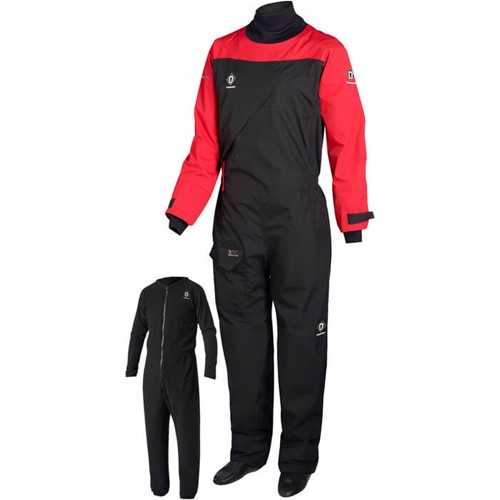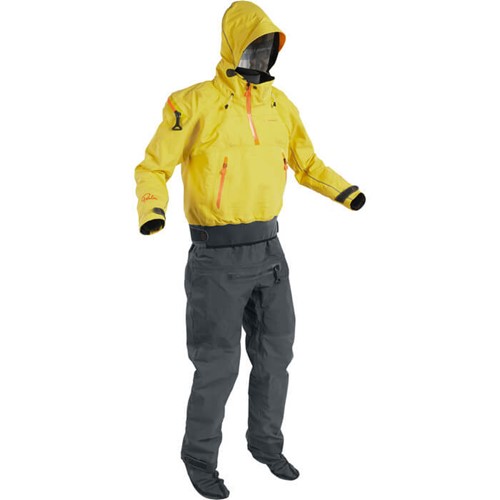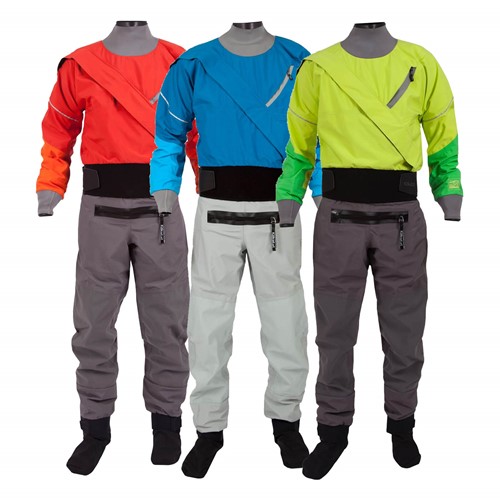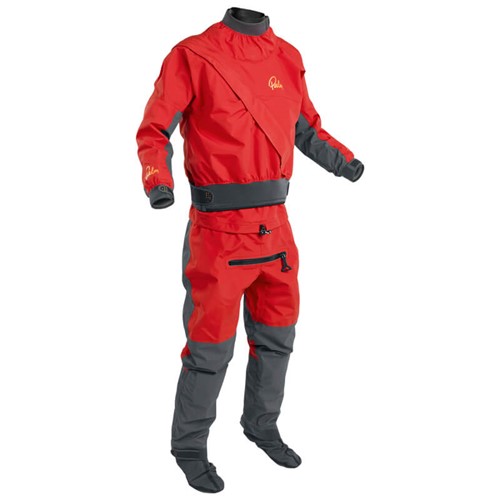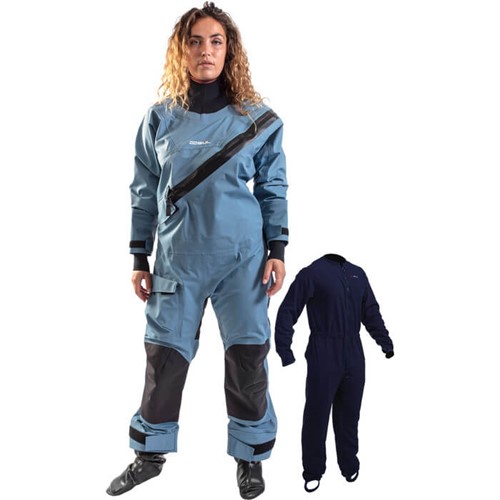Kayaking is one of the most enjoyable water sports out there. There's no better feeling than hitting the water armed with your paddle.
But is that all you need?
Your swimming costume and lifejacket may suffice in the throes of summer, but harsher conditions call for something more substantial. Let's face it–kayaking in colder waters isn't fun if you're soaking wet within the first five minutes.
Here's our list of the best drysuits for kayaking to keep you warm and dry in even the coldest waters.
1. Crewsaver Atacama Sport drysuit for kayaking, £319.95 (RRP £435)
Key specifications:
- Fully breathable 3-layer fabric
- Glideskin neoprene wrist and neck seals
- Front entry
This is one of the best budget drysuits for kayaking, as it's modelled from the best-selling Crewsaver Atacama Pro and retains most of its features. It also comes with a free undersuit included with your purchase.
A 3-layer breathable fabric covers the entirety of this drysuit, whereas previous models were only partially manufactured with breathable material. This makes it a better choice all-round, especially during the warmer months.
Glideskin neoprene (learn more in this glossary of terms) is a single lined form of neoprene that insulates the body from windchill. Since this is used for the wrist and neck seals, your body will benefit from extra insulation in colder waters and the suit's breathability.
The YKK Aquaseal zip is fully waterproof and positioned for added comfort and a greater range of motion—so you need not worry about your movement being restricted.
Durability is no issue for the Crewsaver Atacama Sport, as it comes with a reinforced seat and knees to keep it in top condition and protect it from the elements.
Related: 7 items you need to have on your kayak
2. Palm Bora Touring drysuit for kayaking, £706.95 (RRP £784.95)
Key specifications:
- TIZIP Masterseal entry and relief zips
- Fully adjustable storm hood
- Front entry
On the lookout for a drysuit for sea kayaking? If so, the Palm Bora Touring kayaking drysuit is the ideal choice.
It comes with a Glideskin neck seal, has an adjustable storm hood and double taped socks to protect you from extreme conditions.
The TIZIP Masterseal entry and relief zips offer a high level of water, pressure, and air resistance, providing maximum insulation and keeping you dry. The YKK AquaGuard zips used on the front pockets will protect your belongings, too.
Sea kayaking drysuits need to withstand wear and tear, so it's good that the Palm Bora Touring suit comes with reinforced elbows, seat, and knees to keep these vulnerable areas intact.
3. Kokatat gore-tex meridian dry suit, £899 (RRP £1,349.99)
Key specifications:
- Dual-adjustable overskirt
- Nylon 3-layer GORE-TEX
- Front entry
Constructed with 3-layer GORE-TEX fabric, this dry suit is heavily waterproof, windproof, and breathable, making it worth every penny for those kayaking in all weather conditions.
One of its most unique features is the dual-adjustable overskirt paired with a smoothskin neoprene waistband. They work in tandem to keep water out of your cockpit, helping you avoid any unnecessary discomfort whilst out on the water.
The punch-through neck and wrist neoprene over-cuffs are self-draining, as well as the Cordura seat and knee patches, and designed to keep the suit's interior as dry as a bone.
Every suit is 100% fill tested and guaranteed to be dry.
Related: Why you need kayak insurance
4. Palm Cascade drysuit in flame/jet grey, £518 (RRP £575)
Key specifications:
- 20,000mm waterproof
- TIZIP Masterseal entry and relief zips
- Front entry
If you liked the Palm Bora Touring drysuit but looking for something more budget-friendly, their Cascade drysuit is a great alternative.
The price difference is largely down to the fact the Bora Touring suit is designed for sea kayaking, while the Cascade is slightly lighter yet still perfectly suited for regular kayaking.
It has a 20,000mm waterproof rating, which is exactly what you should look for in a dry suit, as anything lower than this could begin to retain water if you're kayaking for a prolonged period.
The Cascade also comes with latex gaskets on the neck and wrist seals, as well as an adjustable collar and cuffs, which are more than sufficient for insulation and keeping water out.
The CP 4-layer socks will keep your feet dry, and the Velcro adjustable neoprene waistband will keep the suit in place without restricting your movement.
5. GUL Dartmouth eclip zip drysuit, £359.95 (RRP £399.95)
Key specifications:
- 100% waterproof heat taped seams
- Contoured body panels
- Front entry via a YKK Aquaseal zip
This product from GUL is another budget option that made our list of the best kayaking drysuits due to its excellent quality.
It features GUL's GCX3 3-layer fabric, which is fully waterproof, durable, and breathable. The seams are 100% waterproof thanks to being heat taped, so you can rest assured that the suit's interior will remain dry in all conditions.
Like the Crewsaver Atacama, it features a high-quality YKK Aquaseal zip that allows easy access to the suit and keeps moisture at bay.
For added comfort, the internal adjustable braces can be used to achieve a better fit. You can customise the suit to maximise freedom of movement and prevent any restrictions.
Windage reduction comes from the contoured body panels that reduce bulk and snagging.
Related: Waterproof and breathability ratings explained
How to choose a drysuit for kayaking
1. Material
Drysuits used for kayaking should be:
- fully waterproof
- insulating
- breathable
GORE-TEX is a tough laminate fabric ideal for drysuits, but it can be expensive. If products such as this are out of your budget, you could opt for those constructed from nylon or propriety laminate materials.
The latter is a cheaper alternative to GORE-TEX, usually created under a different brand name. It can offer great breathability, but it's not typically as effective. We recommend reading reviews of products with a 3-layer fabric manufactured by a different brand.
2. Fit
There are typically two fits to choose from–either tight or loose.
If you are kayaking in cold waters or during conditions that provide a high risk of immersion, we'd suggest a loose-fitting drysuit for safety reasons.
Otherwise, if you'll be kayaking in milder conditions and the risk of immersion is low, we'd recommend choosing a tighter fit. This will reduce bulk and make you more comfortable in this context.
3. Seals
Otherwise known as gaskets, the seals are one of the most crucial drysuit components for kayaking.
If a drysuit isn't equipped with tough seals, it won't be fully waterproof, no matter how high-quality the material it's constructed from.
We'd recommend looking out for neoprene or latex seals, as both are water-tight.
4. Entry type
Drysuits have gained a reputation for being difficult to get into. However, you can minimise this stress by opting for a product with an entry type you feel most comfortable using.
Most people opt for a drysuit with a front entry, as this is usually easier to get into alone. Rear entry drysuits typically require you to enlist the help of a kayaking partner.
Specialist kayak insurance from Insure4Boats
Heading out on your kayak this summer? If so, you need to protect it through the right insurance.
At Insure4Boats, our specialist kayak insurance covers your kayak against theft, loss, or damage. We also include up to £3m Third Party Liability cover as standard if you damage someone else's property or injure another person whilst kayaking.
We'll also repair or replace your kayak if it was purchased new in the last three years, helping you get back out on the water in no time.
Click here to discover more about how we can help, or hit the button below to get an instant online quote today.
Please note the information provided on this page should not be taken as advice and has been written as a matter of opinion. For more on insurance cover and policy wording, see our homepage.

